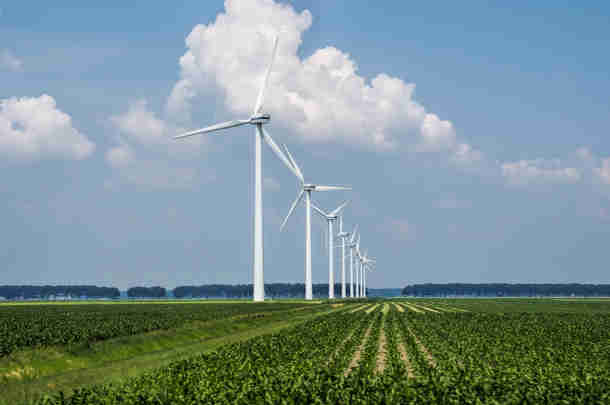Berenschot and Kalavasta have developed four integrated climate-neutral scenarios for the Dutch energy system in 2050. This study was commissioned by Gasunie, TenneT and the regional energy network operators in the Netherlands and produced in close cooperation with the Dutch ministry of Economic Affairs and Climate. Key findings of this study have been presented by the energy and climate policy minister to Parliament.
Introduction
The network operators in the Netherlands want to prepare for the climate-neutral vision set out in the Dutch Climate Agreement. After all, the investments that network operators make in the energy infrastructure are for the long term. It takes time to install power lines, sustainable gas distribution networks and other energy supply infrastructure, which itself has a long-life cycle. The energy transition involves radical changes for all energy carriers in respect of transport and storage, supply and demand.
In order to provide a proper response to these challenges, the network operators and other parties to the Dutch Climate Agreement decided to conduct a phased exploratory study on the options for an integrated energy infrastructure (known in Dutch as the integrale infrastructuurverkenning 2030-2050, or II3050). Berenschot and Kalavasta conducted in cooperation with the network operators phase 1 of II3050. For phase 1 four scenarios for ‘climate neutrality in the Netherlands’ in 2050 were developed. These scenarios have been established not as four separate options to choose from, but to flag the four corners of the future energy mix on which these developments could play out in practice.
Concise summary of the applied methods and results
To create future energy demand projections Berenschot and Kalavasta gathered information about the main sectors in the Netherlands, which are the build environment, mobility, industry, agriculture and the electricity sector. Particular emphasis was placed on the current energy supply and feedstock of the 5 biggest chemical clusters in the Netherlands. This information was gathered by desk research and sending out a questionnaire to industry leaders, and followed up with several interviews with the separate industry clusters. In-depth intelligence about the current energy balances (energy and feedstock) of these clusters was gathered and processed in order to fit the modelling of the energy transition of the industry sectors.
To create future energy supply projections interviews with associations for renewable power took place to gather the newest insights in the field of solar and on/offshore wind power. With the information obtained from these interviews and modelling steps that followed, four energy scenarios were constructed, which primarily focus on the future demand and supply of (renewable) energy carriers. In the scenario’s that endeavour an autonomous energy system, modelling took place to create a balanced energy system. The main objective was to establish a seasonal balance and avoid loss of load and black-out hours. This balanced energy system did not solely focus on renewable electricity, but also on (green) hydrogen production, heat production and biomethane production. Therefore the required future storage capacities for hydrogen and (bio)methane were calculated. Finally, the impact of extreme weather conditions were explored to create more robust scenarios, as extreme weather conditions have major impact on the supply and demand of energy carriers.
The transition towards renewable energy carriers affects the current energy system, therefore the four scenarios were constructed to assess this effect on the energy infrastructure. The outcomes of the study are currently used by TSO’s and DSO’s for long-term grid investment planning. Although, these scenarios are in principal developed for Dutch TSO’s and DSO’s, other parties/stakeholders within the energy transition are able to use these scenario’s and base their future (investment) plans on this research’ outcomes. The four scenarios have similarities but differ. For instance in the build environment each scenario has a different focus and as such mix in 2050 towards heating solutions (key options are: district heating, all-electric, hybrid electricity/biomethane or electricity/hydrogen). The industrial energy transition also differs, as well as the mix of climate neutral energy carriers with different emphasis on renewable generation, decarbonized fossil solutions and hydrogen imports. At the same time, the scenarios provide general insights (so-called no-regrets) as they share the same basic system principles for energy infrastructure and security of supply.
The network operators will examine the need for energy infrastructure in more depth in subsequent phases of the exploratory study on integrated energy infrastructure 2030-2050.
More information
- Download the four climate neutral scenario’s (available in English) (pdf, 5.5 MB)
- Download the complete scenario study (in Dutch only). (pdf, 5 MB)
To supplement this exploratory study, at the request of the Dutch Ministry of Economic Affairs Berenschot and Kalavasta developed a fifth 2050 Climate Neutral scenario. This separate variant study focused on the impact and options for including nuclear energy in the climate-neutral future (in Dutch only).
Berenschot has been working for many years with local authorities, regional and national governments, businesses, networks and partnerships, and branch associations to find answers to all the questions relating to the energy transition. Are you wondering what the energy transition means for your organization and environment in the long term? Would you like to know more about how these scenarios could help? Please contact us.
